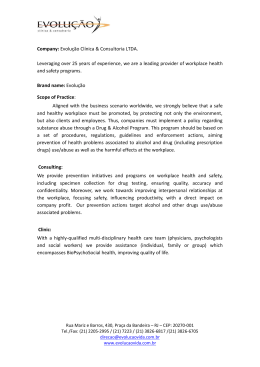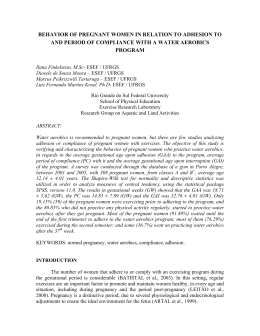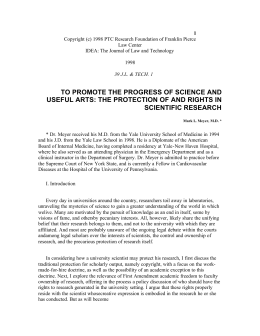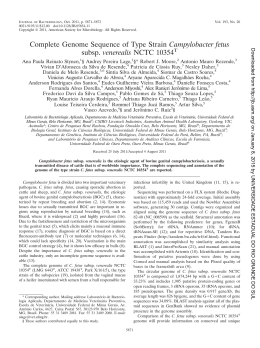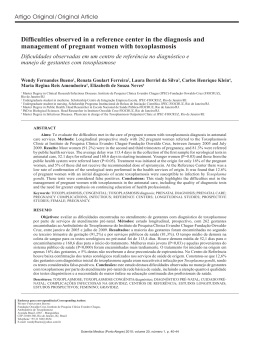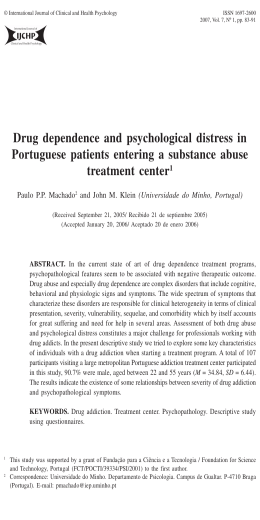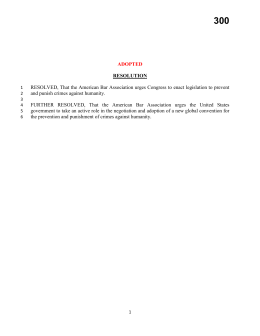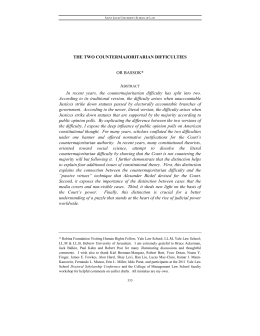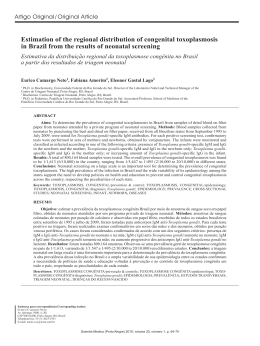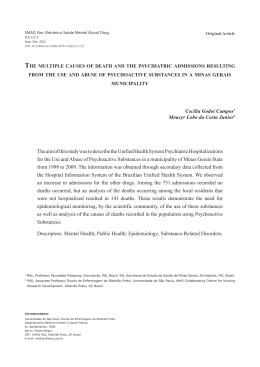4 ADAMS 1353-1374 (DO NOT DELETE) 7/23/2014 10:30 AM CHEMICAL ENDANGERMENT OF A FETUS: SOCIETAL PROTECTION OF THE DEFENSELESS OR UNCONSTITUTIONAL INVASION OF WOMEN’S RIGHTS? I. INTRODUCTION ..................................................................................... 1354 II. HISTORY .............................................................................................. 1354 III. CASES IN ALABAMA ........................................................................... 1359 IV. ARGUMENTS FOR AND AGAINST ....................................................... 1361 A. Public Policy Against Prosecuting Women for Drug Use While Pregnant ...................................................................... 1362 1. Pregnant Women Will Not Seek Medical Treatment or Proper Prenatal Care and May Choose to Have an Abortion for Fear of Facing Criminal Charges .............. 1362 2. Incarceration Is Not a Cure for Drug Addiction and May Actually Be Harmful ................................................ 1365 3. Separation of Families Is Against Public Policy Unless Absolutely Necessary ....................................................... 1366 4. Criminalizing Behavior During Pregnancy Can Lead Down a Slippery Slope..................................................... 1366 B. Public Policy for Prosecuting Women for Drug Use While Pregnant ................................................................................ 1368 1. Prosecuting Women Will Have a Deterrent Effect .......... 1368 2. Women Who Harm Their Fetuses Through Drug Use Deserve to Be Punished ................................................... 1368 3. Criminalizing This Behavior Will Increase Public Health .............................................................................. 1370 C. Constitutional Arguments ...................................................... 1371 D. Statutory Interpretation ......................................................... 1372 V. CONCLUSION ....................................................................................... 1373 4 ADAMS 1353-1374 (DO NOT DELETE) 1354 7/23/2014 10:30 AM Alabama Law Review [Vol. 65:5:1353 I. INTRODUCTION According to one article, “Since the late 1980’s, . . . at least 200 women in more than 30 states have been prosecuted for behavior while pregnant that posed danger to their fetuses.”1 Such behavior includes using illegal drugs and alcohol, both of which are commonly known to cause birth defects and other problems during pregnancy. Prosecutors around the country have found innovative ways to charge women for this behavior, as most states do not have a statute that expressly criminalizes drug or alcohol use while pregnant. These tactics include charging women with child abuse, delivery of a controlled substance, child endangerment, and even homicide. Most cases in which pregnant women are prosecuted for drug use while pregnant have failed. Alabama and South Carolina are the only two states where convictions have been upheld by the states’ supreme courts.2 The Supreme Court of the United States has so far denied certiorari on all cases that have been appealed to it, but the split is growing, and the Court will likely weigh in soon. This Note will present both sides of the debate but will ultimately conclude that prosecutions of women for drug and alcohol use while pregnant will not survive review by the Supreme Court. While the public policy arguments seem, on balance, to support prosecution, the constitutional implications concerning equal protection will most likely triumph. Part II of this Note will examine the historical roots of prosecutions for drug use by pregnant women. Part III will evaluate the arguments for and against allowing such prosecutions. These arguments can be roughly divided into three broad categories: public policy concerns, constitutional implications, and statutory construction arguments. Part IV will explore the prosecution of women under Alabama’s Chemical Endangerment of a Child statute. Part V will assess the future of this debate. This Note does not address the many possible health effects that drug use can have on fetuses. The scholarship on that topic is well developed, and it is common knowledge that certain drugs can cause harm to fetuses. II. HISTORY South Dakota was the first state to pass laws mandating that pregnant women using drugs during pregnancy be taken into custody and forced to 1. Don Terry, In Wisconsin, a Rarity of a Fetal-Harm Case, N.Y. TIMES, Aug. 17, 1996, http://www.nytimes.com/1996/08/17/us/in-wisconsin-a-rarity-of-a-fetal-harm-case.html. 2. Ex parte Ankrom, No. CC-09-395 & No. CC-08-381, 2013 WL 135748, at *1 (Ala. Jan. 11, 2013); Christa J. Richer, Note, Fetal Abuse Law: Punitive Approach and the Honorable Status of Motherhood, 50 SYRACUSE L. REV. 1127, 1130 (2000). 4 ADAMS 1353-1374 (DO NOT DELETE) 2014] Chemical Endangerment of a Fetus 7/23/2014 10:30 AM 1355 participate in rehabilitation.3 The law, passed in 1998,4 gives relatives5 and state officials6 the power to force pregnant women to undergo treatment for drug abuse. Relatives may order the commitment of pregnant women for a maximum of two days.7 Judges may order commitment for up to nine months.8 Wisconsin soon followed South Dakota with the so-called “cocaine mom” law.9 Under that law, any harm done to a fetus by the mother’s drug use explicitly constitutes child abuse.10 The cocaine mom law allows for confinement in a treatment center for pregnant women who abuse drugs or alcohol.11 These laws are becoming more and more common. For example, Florida law provides that harm to a child caused by in vitro exposure to alcohol or drugs can be established upon the child testing positive for those substances immediately after birth.12 Illinois law dictates that the presence of an illegal drug or controlled substance in a newborn is prima facie evidence of child abuse.13 These statutes have the effect of declaring drug use by pregnant women child abuse. Long before laws explicitly criminalized this behavior, however, prosecutors found innovative ways to charge women under existing drug laws. One of the earliest examples of this is Reyes v. Superior Court, a 1977 California case in which a heroin addict was charged with child endangerment after her twins were born with heroin in their systems.14 Reyes was acquitted after the California Court of Appeals determined that the child endangerment law did not apply to fetuses.15 Similarly, in Tennessee, Demetria Jones was charged with aggravated assault on her fetus after cocaine was found in her system.16 The attorney general suggested that Jones could have been charged with reckless endangerment with a deadly weapon.17 Jones ultimately pleaded guilty and was sentenced to time in a work program.18 3. 4. 5. 6. 7. 8. 9. 10. 11. 12. 13. 14. 15. 16. 17. 2008. 18. Richer, supra note 2, at 1130. Shawn Zeller, Fetal Abuse Laws Gain Favor, 30 NAT’L J. 1758 (1998). S.D. CODIFIED LAWS § 34-20A-70 (1994). S.D. CODIFIED LAWS § 34-20A-63 (1994). Zeller, supra note 4. Id. Id. WIS. STAT. ANN. § 48.02(am) (West 2011). WIS. STAT. ANN. § 48.193 (West 2011). FLA. STAT. ANN. § 39.01(32)(g) (West 2009). 705 ILL. COMP. STAT. ANN. § 405/2-18(2)(h) (West 2007). 75 Cal. App. 3d 214, 216 (1977). Id. Chris Echegaray, Are Drugged Babies’ Mothers Guilty?, TENNESSEAN, May 19, 2009. Claudia Pinto, Medical Officials Question Arrest of Pregnant Patient, TENNESSEAN, April 24, Echegaray, supra note 16. 4 ADAMS 1353-1374 (DO NOT DELETE) 1356 7/23/2014 10:30 AM Alabama Law Review [Vol. 65:5:1353 Attorneys have also used statutes prohibiting the delivery of drugs to a minor to prosecute pregnant women.19 The theory of these cases is that pregnant women “deliver” drugs to their fetuses through the umbilical cord.20 Such cases have rarely been successful. In 1992, for example, the Florida Supreme Court held that delivery laws did not apply to transfer through the umbilical cord.21 Charging pregnant addicts under child abuse laws did not become common until the 1990s.22 In one of the first of these cases, Diane Pfannenstiel of Wyoming faced charges of child abuse when alcohol was found in her system while she was pregnant.23 The Wyoming child abuse statute at issue made injury to the child a necessary element of the crime.24 Pfannenstiel’s case was dismissed after a judge determined that the state was unable to sufficiently prove that element.25 Before the Alabama Supreme Court case in early 2013, South Carolina was the only state whose supreme court had upheld criminal prosecutions of pregnant women for drug use during pregnancy.26 The case, Whitner v. State, involved a woman who gave birth to a child that had cocaine in its system.27 Whitner pled guilty to criminal child neglect for using cocaine while pregnant and was sentenced to serve eight years in prison.28 The Supreme Court of South Carolina reviewed the case on Whitner’s petition for post-conviction relief, which the lower court had granted on grounds of ineffective assistance of counsel.29 The court reversed, holding that there was no error in Whitner’s plea.30 The court cited its previous decisions declaring that the definition of the term “child” included a viable fetus.31 The court stated, “[I]t would be absurd to recognize the viable fetus as a person for purposes of homicide laws and wrongful death statutes but not 19. See Johnson v. State, 602 So. 2d 1288 (Fla. 1992); People v. Hardy, 469 N.W.2d 50 (Mich. Ct. App. 1991); Ex parte Perales, 215 S.W.3d 418 (Tex. Crim. App. 2007); Ward v. State, 188 S.W.3d 874 (Tex. Ct. App. 2006). 20. Johnson, 602 So. 2d at 1290. 21. Id. at 1290–91 (adopting the text of Judge Sharp’s dissent in Johnson v. State, 578 So. 2d 419, 421–27 (Fla. Dist. Ct. App. 1991) (Sharp, J., dissenting)). 22. Krista Stone-Manista, Comment, Protecting Pregnant Women: A Guide to Successfully Challenging Criminal Child Abuse Prosecutions of Pregnant Drug Addicts, 99 J. CRIM. L. & CRIMINOLOGY 823, 829 (2009). 23. Ellen Goodman, Troubled Pregnant Women Turn to the System—and the System Turns Against Them, MIAMI HERALD, February 10, 1990. 24. Stone-Manista, supra note 22, at 829. 25. Goodman, supra note 23. 26. Richer, supra note 2, at 1130. 27. 492 S.E.2d 777, 778 (S.C. 1997). 28. Id. at 778–89. 29. Id. at 779. 30. See id. 31. Id. at 779–80. 4 ADAMS 1353-1374 (DO NOT DELETE) 2014] Chemical Endangerment of a Fetus 7/23/2014 10:30 AM 1357 for purposes of statutes proscribing child abuse.”32 Whitner argued that criminalizing drug use by pregnant women would lead to criminalization of other behaviors during pregnancy that were otherwise legal, such as smoking or drinking.33 The court rejected this slippery slope argument, stating that child abuse after the child is born is not defined according to the legality of the underlying action.34 Rather, child abuse is defined by the effect of the action.35 The court also rejected an argument based on the rule of lenity, claiming that because the statute is not ambiguous the rule does not apply.36 Finally, Whitner contended that she lacked fair notice that her conduct constituted child abuse.37 The court rejected that argument as well, claiming that the fact that cocaine has the potential to harm fetuses is common knowledge.38 Shortly after Whitner was affirmed, South Carolina passed a law providing for a possible jail time sentence for pregnant women who abuse drugs or alcohol.39 Courts have also charged pregnant addicts with more serious crimes, such as murder.40 In 1996, Deborah Zimmerman was charged with firstdegree reckless injury and attempted first-degree intentional homicide of her unborn child.41 Zimmerman was taken to a hospital from a local bar, where she had been drinking, when she believed she was going into labor.42 She allegedly told one of the nurses at the hospital that she intended to keep drinking until both she and the fetus died unless they kept her at the hospital.43 Prosecutors used that statement to establish the intent necessary for the attempted homicide charge.44 The child was born after Zimmerman consented to a doctor-recommended C-section.45 Baby M.M.Z was born with a blood alcohol level of 0.199% and physical indicators of fetal alcohol syndrome.46 The Wisconsin court acquitted Zimmerman of the homicide charge on the theory that the state’s “born alive” rule precluded the homicide law from applying to fetuses.47 The born alive rule originated 32. Id. at 780. 33. Id. at 781. 34. Id. at 781–82. 35. Id. 36. Id. at 784. 37. Id. 38. Id. at 785. 39. Zeller, supra note 4. 40. See, e.g., State v. McKnight, 576 S.E.2d 168 (S.C. 2003); State v. Deborah J.Z., 596 N.W.2d 490 (Wis. Ct. App. 1999). 41. Deborah J.Z., 596 N.W.2d at 491. 42. Id. 43. Id. 44. Terry, supra note 1. 45. Deborah J.Z., 596 N.W.2d at 491. 46. Id. at 491–92. 47. Id. at 493. 4 ADAMS 1353-1374 (DO NOT DELETE) 1358 7/23/2014 10:30 AM Alabama Law Review [Vol. 65:5:1353 in English common law and requires that an infant be born alive in order for a charge of homicide to stand.48 Since the born alive rules requires a baby to be born alive for a homicide charge, the court reasoned, there can be no homicide, or attempted homicide, until after the baby is born.49 The court also cited the plethora of Wisconsin statutes in which the legislature had specifically included fetuses in the realm of those it intended to protect.50 Since this statute did not, the court concluded that the legislature must not have intended it to apply to fetuses.51 Regulating this kind of behavior during pregnancy, according to the court, was a step down a slippery slope.52 It could lead to the court regulating behavior that is completely legal, if it was deemed to be a risk to the fetus.53 The court also referenced several public policy concerns, such as the belief that it is preferable to deal with addiction through treatment rather than incarceration, that women will avoid prenatal care for fear of prosecution, and that it is the legislature’s place to criminalize behavior that is not already explicitly listed in the criminal code.54 Another South Carolina woman, Regina McKnight, holds the dubious honor of being the first woman in the United States to be charged with homicide by child abuse of her own fetus.55 McKnight’s child was stillborn, and a subsequent autopsy determined that the cause of death was cocaine consumption.56 The Supreme Court of South Carolina upheld her conviction and sentence of twenty years.57 The court relied heavily on its earlier decision in Whitner, finding that McKnight ingested cocaine knowing of potential health risks to the fetus and knowing that she was pregnant, findings that were sufficient to create a jury question on whether she acted with the necessary intent for the homicide statute.58 The legislature had apparently amended the homicide by child abuse statute in the interim between the Whitner and McKnight decisions without changing the word “child,” a fact that court found indicative of the legislature’s intent to preserve the court’s construction of the word as including 48. Linda C. Fentiman, Pursuing the Perfect Mother: Why America’s Criminalization of Maternal Substance Abuse Is Not the Answer—A Comparative Legal Analysis, 15 MICH. J. GENDER & L. 389, 400 n.39 (2009). 49. Deborah J.Z., 596 N.W.2d at 493. 50. Id. at 493–94. 51. Id. 52. Id. at 494–95. 53. Id. 54. Id. at 495. 55. Fentiman, supra note 48, at 402. 56. State v. McKnight, 576 S.E.2d 168, 171 (S.C. 2003), rev’d on other grounds, 661 S.E.2d 354 (S.C. 2008). The case was reversed on McKnight’s petition for post-conviction relief due to ineffective assistance of counsel. Id. 57. Id. 58. Id. at 173. 4 ADAMS 1353-1374 (DO NOT DELETE) 2014] 7/23/2014 10:30 AM Chemical Endangerment of a Fetus 1359 fetuses.59 Interestingly, McKnight argued in her appeal that conviction for cocaine use while pregnant invaded her constitutional right to privacy.60 The court rejected this argument, saying that there was no fundamental right to ingest cocaine, either while pregnant or while not pregnant.61 While the court admitted that McKnight suggested genuine policy concerns, such as fear that women will decide to have abortions or fail to seek prenatal care rather than face possible criminal sanctions, the court stated that McKnight was “in reality attempting to assert the privacy rights of other pregnant women, something she does not have standing to do.”62 The state supreme court ultimately reversed the decision denying McKnight’s petition for post-conviction relief due to ineffective assistance of counsel in 2008.63 Alabama and South Carolina are the only states to date that have upheld the prosecutions of pregnant women for drug use.64 As of yet, the United States Supreme Court has denied certiorari on all cases concerning this issue.65 III. CASES IN ALABAMA In 2006, the Alabama legislature passed the Chemical Endangerment of a Child statute. It was intended to punish individuals who manufactured methamphetamine near children.66 Prosecutors have found a different use for the statute, however: prosecuting women who ingest drugs while pregnant.67 Since 2011, at least twenty-five women have been prosecuted for chemical endangerment of a fetus.68 Alabama has been called “the national capital for prosecuting women on behalf of their newborn children.”69 Greg Gambril, one of the first prosecutors behind this movement, stated that the prosecutions were in an effort to protect unborn children, saying, “We are doing this for the sole purpose of trying to make sure both the mother and the child have a healthy pregnancy.”70 To that 59. Id. at 175. 60. Id. at 176. 61. Id. 62. Id. 63. Fentiman, supra note 48, at 403. 64. Linda C. Fentiman, Rethinking Addiction: Drugs, Deterrence, and the Neuroscience Revolution, 14 U. PA. J.L. & SOC. CHANGE 233, 237–38 (2011). 65. Richer, supra note 2, at 1130. 66. Dave Parks, New Ala. Law Being Used to Prosecute Drug-Using Moms, ASSOCIATED PRESS, Feb. 14, 2008. 67. Fentiman, supra note 48, at 408. 68. Fentiman, supra note 64, at 238. 69. Ada Calhoun, Mommy Had to Go Away for a While, N.Y. TIMES MAG., April 29, 2012, at 32. 70. Parks, supra note 66. 4 ADAMS 1353-1374 (DO NOT DELETE) 1360 7/23/2014 10:30 AM Alabama Law Review [Vol. 65:5:1353 end, the goal is to get pregnant women into treatment.71 Gambril stated that his office settles once the woman agrees to receive treatment.72 Hope Ankrom and Amanda Kimbrough were both charged with chemical endangerment of a child for drug use while pregnant73 and pled guilty.74 This term, their cases were combined for review before the Alabama Supreme Court.75 With these cases, the court decided that the word “child” in the chemical endangerment statute includes fetuses.76 Hope Ankrom gave birth to a son who tested positive for cocaine on January 31, 2009.77 Medical records revealed that Ankrom had tested positive for both cocaine and marijuana multiple times while she was pregnant.78 On February 18, 2009, Ankrom became one of the first women in Alabama to be charged with chemical endangerment on the theory that she had caused her fetus to ingest cocaine.79 Ankrom eventually pled guilty and was sentenced to a three-year suspended sentence and one year of probation.80 Amanda Kimbrough gave birth to a son on April 29, 2008 after testing positive for methamphetamine.81 She was less than twenty-six weeks pregnant, and the child lived less than twenty minutes.82 The medical examiner determined that the child had died from acute 71. 72. 73. Id. Id. ALA. CODE § 26-15-3.2 (1975) reads as follows: (a) A responsible person commits the crime of chemical endangerment of exposing a child to an environment in which he or she does any of the following: (1) Knowingly, recklessly, or intentionally causes or permits a child to be exposed to, to ingest or inhale, or to have contact with a controlled substance, chemical substance, or drug paraphernalia as defined in Section 13A-12-260. A violation under this subdivision is a Class C felony. (2) Violates subdivision (1) and a child suffers serious physical injury by exposure to, ingestion of, inhalation of, or contact with a controlled substance, chemical substance, or drug paraphernalia. A violation under this subdivision is a Class B felony. (3) Violates subdivision (1) and the exposure, ingestion, inhalation, or contact results in the death of the child. A violation under this subdivision is a Class A felony. (b) The court shall impose punishment pursuant to this section rather than imposing punishment authorized under any other provision of law, unless another provision of law provides for a greater penalty or a longer term of imprisonment. (c) It is an affirmative defense to a violation of this section that the controlled substance was provided by lawful prescription for the child, and that it was administered to the child in accordance with the prescription instructions provided with the controlled substance. 74. Ex parte Ankrom, No. CC-09-395 & No. CC-08-381, 2013 WL 135748, at *1–2 (Ala. Jan. 11, 2013). 75. Id. 76. Id. 77. Id. 78. Id. at *1. 79. Id.; Calhoun, supra note 69. 80. Ex parte Ankrom, 2013 WL 135748, at *2. 81. Id. at *3. 82. Id. 4 ADAMS 1353-1374 (DO NOT DELETE) 2014] Chemical Endangerment of a Fetus 7/23/2014 10:30 AM 1361 methamphetamine intoxication as a result of his mother’s drug use.83 Kimbrough pled guilty to chemical endangerment of a child and was sentenced to ten years in jail.84 Both Ankrom and Kimbrough filed appeals, alleging essentially the same arguments.85 In Ankrom’s appeal, the Court of Criminal Appeals held that the term “child” as used in the chemical endangerment statute included a fetus and affirmed her conviction.86 The court reached this decision through analysis of the statute, considering, among other things, the stated public policy of Alabama to protect unborn life, the previous interpretations of the word “child” by the Alabama Supreme Court to include fetuses, the plain meaning doctrine,87 and decisions from other jurisdictions.88 The Alabama Court of Criminal Appeals also affirmed Kimbrough’s conviction in an unpublished opinion.89 Ankrom and Kimbrough again appealed on three grounds, arguing that the chemical endangerment statute does not apply to fetuses, that applying the statute to fetuses is bad public policy, and that applying the statute to fetuses is unconstitutional.90 These arguments are explored further below. The Alabama Supreme Court combined the cases and found that the only issue in dispute was whether the child endangerment statute applied to fetuses.91 The court ultimately held “that the plain meaning of the word ‘child’ in the chemicalendangerment statute includes an unborn child or fetus.”92 The court therefore affirmed the Alabama Court of Criminal Appeals decisions, with the caveat that it “expressly reject[ed] the Court of Criminal Appeals’ reasoning insofar as it limits the application of the chemical-endangerment statute to a viable unborn child.”93 IV. ARGUMENTS FOR AND AGAINST The main arguments advanced on both sides of this debate fall into three categories: public policy, constitutional, and statutory construction. Public policy arguments cover a wide range of topics, but focus primarily on increasing public health and ensuring children are born healthy. 83. 84. 85. 86. 2011). 87. 88. 89. 90. 91. 92. 93. Id. Id. at *2. Id. at *4. Ankrom v. State, No. CR-09-1148, 2011 WL 3781258, at *8, *11 (Ala. Crim. App. Aug. 26, Id. at *5. Id. at *5–8. Ex parte Ankrom, 2013 WL 135748, at *7. Id. at *8. Id. at *7. Id. at *20. Id. 4 ADAMS 1353-1374 (DO NOT DELETE) 1362 7/23/2014 10:30 AM Alabama Law Review [Vol. 65:5:1353 Constitutional arguments focus on the right to privacy, fair notice and due process, and equal protection. Finally, statutory construction arguments manipulate the rules of statutory interpretation to reach the desired result. A. Public Policy Against Prosecuting Women for Drug Use While Pregnant 1. Pregnant Women Will Not Seek Medical Treatment or Proper Prenatal Care and May Choose to Have an Abortion for Fear of Facing Criminal Charges There is a risk that fetal abuse statutes discourage pregnant women from seeking medical attention for fear of prosecution or losing their children. Not only will these women not receive substance abuse treatment, but their fear is likely to discourage them from seeking prenatal care as well. Some women who would otherwise have obtained prenatal care may not because they are uncertain about what behavior could have criminal repercussions. Drinking alcohol, for example, is not illegal in itself, but some jurisdictions have prosecuted women for drinking alcohol while pregnant.94 Women may be reluctant to go to the doctor if they fear they will be reported to the authorities. Furthermore, fetal abuse statutes make drug use while pregnant a separate crime from regular drug use codes.95 This means that pregnant women can be charged with both crimes. The added crime and penalty may act as an additional deterrent to seeking help. Some jurisdictions have experimented with a system in which doctors report pregnant women they suspect of using drugs to the authorities.96 A reporting system could create an even stronger deterrent effect on women seeking prenatal care. Women are unlikely to seek appropriate care if they fear their doctor may report them to the police. Even if a woman does seek care, she will undoubtedly not tell her physician about any drug use, which may prevent the doctor from offering appropriate advice or service. Hospitals that do not have an official policy addressing pregnant women who test positive for drugs may still report positive results to Human Resources or the appropriate agency, which may then call police. A nurse practitioner at a hospital in Alabama, for example, said in an interview that she reported all instances indicative of possible child abuse to the Department of Human Resources, and she considered a positive drug test to fall within that category.97 94. 95. 96. 97. State v. Deborah J.Z., 596 N.W.2d 490, 491 (Wis. Ct. App. 1999). Fentiman, supra note 48, at 399. See Ferguson v. City of Charleston, 532 U.S. 67, 70–72 (2001). Parks, supra note 66. 4 ADAMS 1353-1374 (DO NOT DELETE) 2014] Chemical Endangerment of a Fetus 7/23/2014 10:30 AM 1363 The Supreme Court addressed hospital-reporting systems in Ferguson v. City of Charleston in 2001.98 The case involved a public hospital in South Carolina that worked with police to create a policy that would notify police of pregnant women who tested positive for cocaine.99 At the first positive test, women were to be given a chance to attend treatment.100 If the woman tested positive a second time, however, police were notified.101 If the woman was less than twenty-eight weeks pregnant, prosecutors charged her with possession; if she was more than twenty-eight weeks, prosecutors charged her with possession and distribution.102 If a woman tested positive for cocaine while in labor, she was charged with possession, distribution, and unlawful neglect of a child.103 Ferguson and nine other women arrested under this policy sued the city, claiming that the drug tests constituted unconstitutional searches.104 The Court first found that the drug tests were searches under the Fourth Amendment.105 The Court then distinguished the case from cases in which a special need warranted suspicionless searches on the ground that the primary goal of the policy in this case was “the use of law enforcement to coerce the patients into substance abuse treatment.”106 The real purpose of the policy, according to the Court, was to produce evidence (positive drug tests) that could be used against these women in court proceedings.107 It did not matter that the overall goal was the furtherance of the health of the women and their children by forcing them to choose between receiving treatment for addiction and facing criminal charges.108 The Court held that the policy violated Fourth Amendment protections.109 This case is telling. If medical personnel are required or allowed to report prenatal drug use, it is likely that women will avoid seeking any sort of medical care for fear of prosecution or other consequences. Even if women only believe that doctors can report them, they may decide not to seek medical care. As a result of the concern that pregnant drug users will not seek help for fear of prosecution, many large medical and health organizations have issued statements opposing criminalizing this behavior.110 The American 98. 99. 100. 101. 102. 103. 104. 105. 106. 107. 108. 109. 110. See generally Ferguson, 532 U.S. 67. Id. at 71–72. Id. at 72. Id. Id. Id. at 73. Id. Id. at 76. Id. at 79–80. Id. at 82–83. Id. at 82–84. Id. at 85–86. Stone-Manista, supra note 22, at 836. 4 ADAMS 1353-1374 (DO NOT DELETE) 1364 7/23/2014 10:30 AM Alabama Law Review [Vol. 65:5:1353 Medical Association and the American Academy of Pediatrics are both opposed to these prosecutions.111 The American Psychiatric Association issued an official statement in March of 2001, declaring that it “oppose[d] the criminal prosecution and incarceration” of women for “child abuse charges based solely on the use of substances during pregnancy.”112 The statement expressed fear that pregnant women would not receive the necessary prenatal care for fear they could face criminal charges.113 Some suggest that pregnant women may choose to have abortions rather than face a criminal penalty. This risk is particularly acute in jurisdictions that do not limit the application of child abuse statutes (and other similar statutes that may be used in drug prosecutions) to viable fetuses. Furthermore, in many jurisdictions, the penalty for an illegal abortion is less severe than the penalty women would face for drug use while pregnant.114 One attorney who represented a woman faced with criminal punishment for her conduct while pregnant quoted her client as stating, “I’m going to jail because I didn’t have an abortion.”115 Another defense attorney spoke against these prosecutions, saying she had a client who refused to go to the hospital when she went into labor for fear of criminal consequences if she tested positive for drugs.116 The woman instead gave birth at home with no medical assistance.117 Finally, women who have faced criminal charges may have trouble if they file for government assistance later.118 Felony convictions may limit the amount of assistance a woman is able to receive.119 For a woman who retained custody of her child, this could have disastrous consequences for her and society as a whole. 111. State v. Deborah J.Z., 596 N.W.2d 490, 495 n.6 (Wis. Ct. App. 1999) (“Many health and public welfare officials feel that the most effective way of preventing substance abuse in pregnant women is through education about potential harms and the provision of comprehensive treatment for their abuse. . . . [C]riminal penalties may exacerbate the harm done to fetal health by deterring . . . [the women] from obtaining help or care.” (quoting Report of the American Medical Association Board of Trustees, Legal Interventions During Pregnancy, 264 JAMA 2663, 2667–68 (1990)); Stone-Manista, supra note 22, at 836. 112. AM. PSYCHIATRIC ASS’N, POSITION STATEMENT ON CARE OF PREGNANT AND NEWLY DELIVERED WOMEN ADDICTS (2001), http://www.psychiatry.org/advocacy--newsroom/positionstatements. 113. See id. 114. See Reyes v. Superior Court, 75 Cal. App. 3d 214, 218 (1977); Whitner v. State, 492 S.E.2d 777, 788 (S.C. 1997) (Moore, J., dissenting); Richer, supra note 2, at 1148. 115. Zeller, supra note 4 (quoting defense attorney Lynn Paltrow). 116. Matt Elofson, Chemical Endangerment Charge Questioned, DOTHAN EAGLE, Oct. 23, 2010, http://www.dothaneagle.com/news/article_f1bb8be5-f5e0-5c38-94be-838b865fe38d.html. 117. Id. 118. Id. 119. Id. 4 ADAMS 1353-1374 (DO NOT DELETE) 2014] Chemical Endangerment of a Fetus 7/23/2014 10:30 AM 1365 2. Incarceration Is Not a Cure for Drug Addiction and May Actually Be Harmful Practically, incarceration offers no cure for substance abuse, and many health officials claim that treatment would be a much better option.120 Some argue that putting pregnant drug users in prison at least keeps them off drugs.121 However, studies have shown that incarceration is less successful at keeping people off drugs than drug treatment programs.122 Additionally, most people would undoubtedly agree it is not impossible to obtain access to drugs in prison. Incarcerating pregnant women may also be harmful if the prison does not have adequate prenatal care facilities. Most prisons are not equipped to provide a sufficient level of prenatal treatment.123 Of course, the other side of this argument is that pregnant addicts are unlikely to seek prenatal care anyway, and the prenatal care available in prison would be better than nothing. Some commentators point to horrible incidents of women giving birth in jail cells, unattended by medical professionals and ignored by guards. For example, a judge in Maryland jailed Kari Parsons (supposedly for failing a drug test while on probation) while she was pregnant.124 She went into labor while still incarcerated, but the guards ignored her pleas for medical attention.125 The guards moved Parsons away from other inmates to a cell by herself.126 There she gave birth to a son, alone.127 The child was born healthy but later developed an infection from the unsanitary conditions of the jail cell where he was born.128 Once a pregnant woman becomes addicted to a drug, there is no easy solution. The woman can comply with the law and stop using drugs, but this decision would likely cause withdrawal, which can be dangerous to the fetus.129 The other option is to continue using the drug, which obviously carries risks as well.130 A woman addicted to opiates may seek help at a methadone clinic, but there is no guarantee that she would not be prosecuted if her child were to be born with methadone in its system. 120. State v. Deborah J.Z., 596 N.W.2d 490, 495 (Wis. Ct. App. 1999). 121. Stone-Manista, supra note 22, at 837 (citing Bennett v. Collier, 95 S.W.3d 782, 783–84 (Ark. 2003)). 122. Pinto, supra note 17. 123. Id. 124. Id.; see also Julie B. Ehrlich, Breaking the Law by Giving Birth: The War on Drugs, the War on Reproductive Rights, and the War on Women, 32 N.Y.U. REV. L. & SOC. CHANGE 381, 390 (2008). 125. Ehrlich, supra note 124, at 390. 126. Id. 127. Id. 128. Id. 129. Richer, supra note 2, at 1144. 130. Id. 4 ADAMS 1353-1374 (DO NOT DELETE) 1366 7/23/2014 10:30 AM Alabama Law Review [Vol. 65:5:1353 Clearly, any course of action carries with it potentially negative consequences. 3. Separation of Families Is Against Public Policy Unless Absolutely Necessary Problems that may arise as a result of removing a child from its mother must also be considered in this debate. Some courts, in their refusal to interpret the word “child” to include fetuses, have said that such an interpretation would conflict with a public policy focused on keeping children with their parents if possible.131 Incarceration of the mother will necessarily result in separation from her child during the child’s infancy. If the woman has other children, they will lose their mother too. Because of these concerns, many states’ public policies dictate that children should not be separated from their mothers if there is an alternative course of action that would keep the child safe.132 4. Criminalizing Behavior During Pregnancy Can Lead Down a Slippery Slope Many opponents fear that holding women legally liable for drug use during pregnancy will lead to government intrusion in other aspects of pregnancy, the first step down a slippery slope. Once it is a crime to ingest drugs while pregnant, it is not a big step toward penalizing instances of poor judgment that could endanger the fetus. Any substance that a pregnant woman ingests with the potential to harm her fetus could run afoul of this law. The Wisconsin court deciding Deborah Zimmerman’s case cited this slippery slope argument.133 The Whitner court had rejected a slippery slope argument, but the Zimmerman court found it persuasive, stating that any “reckless or dangerous conduct . . . could become criminal behavior because the actions were taken while the woman was pregnant.”134 Furthermore, the court noted, the end of this slope could result in the inclusion of “failure to secure adequate prenatal medical care” or “excessive exercising or dieting” as criminal behavior.135 131. State v. Gethers, 585 So. 2d 1140, 1142–43 (Fla. Ct. App. 1991); see also Johnson v. State, 602 So. 2d 1288, 1294 (Fla. 1992). 132. Johnson, 602 So. 2d at 1294. 133. State v. Deborah J.Z., 596 N.W.2d 490, 494–95 (Wis. Ct. App. 1999); see also Kilmon v. State, 905 A.2d 306, 311 (Md. 2005); Johnson, 602 So. 2d at 1294; State v. Wade, 232 S.W.3d 663, 666 (Mo. Ct. App. 2007); Reinesto v. Superior Court, 894 P.2d 733, 736 (Ariz. Ct. App. 1995). 134. Deborah J.Z., 596 N.W.2d at 494–95. 135. Id. at 495 (quoting Hillman v. Georgia, 503 S.E.2d 610, 613 (Ga. Ct. App. 1998)). 4 ADAMS 1353-1374 (DO NOT DELETE) 2014] Chemical Endangerment of a Fetus 7/23/2014 10:30 AM 1367 In 2004, Utah took a step further down this slope.136 Melissa Rowland was charged with first-degree murder after her child was stillborn on the theory that the death was caused by her refusal to undergo a Caesarian section.137 There was also evidence Rowland had abused drugs during her pregnancy.138 Prosecutors claimed that Rowland refused the C-section out of vanity; she didn’t want a scar.139 In an interview, Rowland denied the vanity theory, pointing out that this operation would have been her third Csection.140 Rowland eventually pleaded to child endangerment, and her case never reached trial.141 The prosecutor in the case did not deny that women have a right to choose between medical treatment options while pregnant, but implied that pregnant women could not choose to not receive medical treatment at all.142 Many child abuse statutes criminalize behavior that harms the child regardless of the legality of the behavior. It follows that pregnant women could be prosecuted for a host of legal behaviors that endanger their fetuses, such as smoking or even jaywalking. In fact, women have been prosecuted for consuming alcohol while pregnant.143 A legislator in Arkansas proposed a law in 2006 that would make it illegal for women to smoke while pregnant.144 The proposal was endorsed by current Governor Mike Huckabee but was ultimately unsuccessful.145 The South Carolina Supreme Court explicitly stated in Whitner v. State that it believed the legality of the behavior that causes that abuse is irrelevant.146 Once we disregard the legality of the underlying behavior and focus solely on the safety of the fetus, it is easy to see how slippery the slope becomes. 136. Linda Thomson, Mother Is Charged in Stillbirth of Twin, DESERET NEWS, Mar. 12, 2004, http://www.deseretnews.com/article/595048573/Mother-is-charged-in-stillbirth-of-a-twin.html?pg=all. 137. Id. 138. Fentiman, supra note 48, at 404. 139. Thomson, supra note 136. 140. Id. 141. Fentiman, supra note 48, at 405. 142. Thomson, supra note 136. (“Asked about a woman’s right to make choices during pregnancies, prosecutor Kent Morgan said: ‘She didn’t choose among alternative treatments available. She chose to get no treatment whatsoever.’”). 143. See State v. Deborah J.Z., 596 N.W.2d 490 (Wis. Ct. App. 1999). 144. Parks, supra note 66. 145. Id. 146. Alison M. Leonard, Note, Fetal Personhood, Legal Substance Abuse, and Maternal Prosecutions: Child Protection or “Gestational Gestapo”?, 32 NEW ENG. L. REV. 615, 624–25 (1998). 4 ADAMS 1353-1374 (DO NOT DELETE) 1368 7/23/2014 10:30 AM Alabama Law Review [Vol. 65:5:1353 B. Public Policy for Prosecuting Women for Drug Use While Pregnant 1. Prosecuting Women Will Have a Deterrent Effect Criminalizing drug use while pregnant may have an important deterrent effect. This deterrent effect has two aspects. First, women prosecuted under these statutes are less likely to use drugs during any future pregnancies they may have.147 The second aspect suggests that prosecuting these women will serve as a warning to other women in the community, who are then more likely to avoid drug use during pregnancy.148 Gary McAliley, an Alabama district attorney, stated that one of the reasons that he pursues chemical endangerment cases against pregnant drug users is because he hopes it will deter other women from using drugs while pregnant.149 Punishment is key to his strategy: “It’s important for society to know that [drug use while pregnant] will be prosecuted and dealt with severely.”150 An argument related to deterrence claims that prosecuting these women is a way to force them to seek treatment for their substance abuse problems.151 Incarceration in either a jail or a treatment program forces pregnant women to stop using alcohol or drugs and allows them to receive treatment. The response to this argument is often that prosecution may still cause some women not to seek prenatal care or substance abuse treatment because they are afraid of being charged with a crime.152 Also, as stated above, drugs can likely be obtained in most jails and prisons. 2. Women Who Harm Their Fetuses Through Drug Use Deserve to Be Punished Another argument made in favor of fetal abuse prosecutions of pregnant drug users concerns punishment. Women who use drugs during pregnancy are putting their fetuses at great risk, the argument goes, and are therefore deserving of punishment.153 At least some judges appear to subscribe to this argument. A South Carolina judge, for example, when faced with a woman who used cocaine while pregnant stated, “I’m sick and 147. Stone-Manista, supra note 22, at 832. 148. Id.; see also Lisa Eckenwiler, Why Not Retribution? The Particularized Imagination and Justice for Pregnant Addicts, 32 J.L. MED. & ETHICS 89, 90 (2004). 149. Elofson, supra note 116. 150. Id. (quoting Gary McAliley). 151. Terry, supra note 1. 152. Id. 153. Stone-Manista, supra note 22, at 832. 4 ADAMS 1353-1374 (DO NOT DELETE) 2014] Chemical Endangerment of a Fetus 7/23/2014 10:30 AM 1369 tired of these girls having these bastard babies on crack cocaine and . . . the law they gave me, it said I could put them in jail.”154 A lot of harm is done to innocent children whose mothers use drugs while pregnant.155 Someone should have to pay for that harm, and the guilty party is the mother. Some prosecutors claim that babies born into this sort of environment frequently show up later in their lives as criminal defendants.156 The child, therefore, is punished for the crimes of its mother, but the mother is never held accountable for the damage that she did to her child. Problems at birth are not the only concern; the effects of drug and alcohol use during pregnancy can follow a child for its entire life.157 Fetal Alcohol Syndrome, for example, is a disease that may always cause problems for those born with it.158 The argument in favor of punishment is even stronger when pregnant women who are not addicted to drugs use them recreationally. Tiffany Hitson of Covington County, Alabama was charged with chemical endangerment after her daughter tested positive for both cocaine and marijuana at birth.159 Hitson wrote in a letter to the judge that “I made the biggest mistake of my life [and] did some drugs with her father right before I went into labor, unaware I was about to have her.”160 Apart from the fact that it is unclear whether she believes her mistake was doing drugs or doing drugs right before she went into labor, the letter implies that her use of drugs was entirely recreational and not the result of an addiction. Amanda Kimbrough, one of the women whose case went before the Alabama Supreme Court earlier this year, claims that she only did meth once during her pregnancy.161 Kimbrough went into premature labor, and the child died.162 Addicts at least need to use drugs in order not to experience withdrawal; mothers like Hitson have no such excuse. 154. Id. at 834–35 (quoting Bob Herbert, In America; Pregnancy and Addiction, N.Y. TIMES, June 11, 1998, at A31). 155. Terry, supra note 1. 156. Id. 157. Id.; see also NAT’L INST. ON DRUG ABUSE, PRINCIPLE OF DRUG ADDICTION TREATMENT: A RESEARCH-BASED GUIDE 21 (3d ed. 2012), available at www.drugabuse.gov/sites/default/files/ podat_1/pdf (“Smoking during pregnancy can increase risk of stillbirth, infant mortality, sudden infant death syndrome, preterm birth, respiratory problems, slowed fetal growth, and low birth rate. Drinking during pregnancy can lead to the child developing fetal alcohol spectrum disorders, characterized by low birth rate and enduring cognitive and behavioral problems. Prenatal use of some drugs, including opioids, may cause a withdrawal syndrome in newborns called neonatal abstinence syndrome (NAS). Babies with NAS are at greater risk of seizures, respiratory problems, feeding difficulties, low birth weight, and even death.”). 158. Terry, supra note 1. 159. Adam Nossiter, In Alabama, a Crackdown on Pregnant Drug Users, N.Y. TIMES, Mar. 15, 2008, at A10. 160. Id. (quoting Tiffany Hitson). 161. Calhoun, supra note 69. 162. Id. 4 ADAMS 1353-1374 (DO NOT DELETE) 1370 7/23/2014 10:30 AM Alabama Law Review [Vol. 65:5:1353 3. Criminalizing This Behavior Will Increase Public Health Advocates of criminalizing drug use while pregnant claim that public health will be benefited as a result.163 Any deterrent effect caused by such laws will obviously benefit public health, but the effect will extend further. Any women reported for prenatal drug use will receive treatment, thereby increasing the health of the woman and her fetus.164 Problems associated with prenatal drug use can follow a child for the rest of its life. Much of this damage is permanent, and it can be seriously debilitating.165 Adding criminal penalties for women who use drugs and alcohol while pregnant may incentivize women to quit, which would increase public health overall. The risks associated with drug use are common knowledge, and there is certainly an argument to be made that it is common knowledge that use of drugs can harm a fetus. Some advocates of prosecution claim that cocaine has such serious effects on fetuses that it is clearly child abuse for a pregnant woman to use cocaine.166 There is another perspective to this argument: the child. Providing additional penalties for prenatal drug use may help protect children from mothers who are intent upon drug use during pregnancy. One of the things that must be considered in this debate is the welfare of the child, and the welfare of the child is undoubtedly improved by keeping the mother off drugs. In fact, one of the prosecutors responsible for charging women with chemical endangerment cited the need to protect unborn children as one of the motivating factors in his decision to pursue prosecution.167 Doug Valeska, the Houston Country District Attorney, was unforgiving in his condemnation of pregnant drug users in an interview in 2010.168 He stated that, while his office would certainly consider any efforts by the mother to receive treatment, the proper time for women to seek treatment would have been before they became pregnant.169 Valeska further emphasized that women who use drugs should be taking steps to ensure that they do not become pregnant.170 Other prosecutors take a more treatment-oriented, and more practical, approach. Covington County, for example, settles prenatal chemical endangerment cases as soon as the mother enters a treatment program.171 Approaches to these charges that focus on treatment of the 163. 164. 165. 166. 167. 168. 169. 170. 171. Stone-Manista, supra note 22, at 832–33. Id. at 833. See supra text accompanying footnote 152. Pinto, supra note 17. Parks, supra note 66. Elofson, supra note 116. Id. Id. Parks, supra note 66. 4 ADAMS 1353-1374 (DO NOT DELETE) 2014] 7/23/2014 10:30 AM Chemical Endangerment of a Fetus 1371 underlying problem are much more likely to be successful. For reasons discussed above, incarceration often does not provide a cure to addiction. C. Constitutional Arguments The prosecution of pregnant drug users raises potential equal protection concerns. It is possible that some judges punish pregnant women more harshly than other drug users.172 The South Carolina judge who voiced his frustration at “girls having . . . bastard babies on crack cocaine” seems likely to punish these “girls” more severely.173 This raises the specter of gender bias. Furthermore, use of illegal drugs during pregnancy is a crime that only women can commit. Consequently, criminalizing this behavior will result in heightened penalties for female drug users based on their gender. It makes pregnant women a group that will be treated differently from other citizens in the eyes of the law.174 This is a crime that men cannot be charged with; a crime that men cannot commit. Charging pregnant women with regular drug crimes like possession, or even under child abuse laws, provides some redress to equal protection because those are crimes men can commit as well. A problem still emerges, however, if pregnant women are punished more severely than men or if they are tested for drugs because they are pregnant. Opponents of criminalizing drug use while pregnant claim that such prosecutions present a fair notice and due process problem.175 Pregnant women do not, of course, lack fair notice that using illegal drugs is illegal.176 Pregnant women do, however, lack fair notice that using illegal drugs while pregnant makes them guilty of child abuse, child endangerment, delivery to a minor, or the various other statutes women have been charged with in these cases.177 Of course, this argument hinges on women being unaware that the word “child” includes a fetus. Any child abuse statute that explicitly includes fetuses would solve this problem. Furthermore, many people commonly accept “child” to include fetuses. It is common knowledge that illegal drugs have harmful side effects. This strengthens the claim that women have fair notice that using drugs while pregnant could be considered criminal behavior. 172. 173. 174. 175. 176. 177. Stone-Manista, supra note 22, at 834–35. Id. Calhoun, supra note 69. Stone-Manista, supra note 22, at 850. Id. Id. at 851. 4 ADAMS 1353-1374 (DO NOT DELETE) 1372 7/23/2014 10:30 AM Alabama Law Review [Vol. 65:5:1353 D. Statutory Interpretation One of the fundamental disputes regarding interpretation of many of the statutes at issue in this debate concerns the word “child.” Some courts have refused to charge pregnant women with child abuse because, according to them, a fetus is not a child.178 The first step in statutory analysis is often to determine whether the statute is ambiguous, or if the words have a plain meaning. The plain meaning of the term “child” is ambiguous; there is an argument to be made on either side. Often the result will depend on how a particular state’s courts have ruled on the issue in the past. In analyzing the breadth of the term “child,” courts look to their interpretation of the word in other statutes.179 Courts also consider whether the legislature has explicitly included fetuses in any other laws.180 In State v. Martinez, for example, the court determined that fetuses were not included in the definition of child because New Mexico courts had previously determined that a fetus was not a person under a different law and because the legislature had specifically included fetuses as victims in several other statutes.181 The court reasoned that if the legislature had meant to include fetuses in this law it would have used explicitly done so, as it had in the past.182 The court concluded that it could not constitutionally convict Martinez of child abuse because there was no fair notice that the statute applied to prenatal conduct.183 Many statutes that criminalize harm to a fetus explicitly exclude pregnant women harming their own fetuses from the reach of the statute.184 Courts have also established a line between third party injury to a fetus and injury by the mother.185 The rationale behind this distinction is that the mother has an interest in protecting the fetus that is actionable at law.186 The state does not have this interest and so can only act on behalf of the mother’s interest.187 If a jurisdiction follows this rationale then drug use while pregnant cannot be considered a crime. Not all jurisdictions follow this rule, however. 178. Fentiman, supra note 48, at 399. 179. Stone-Manista, supra note 22, at 831; see State v. Martinez, 137 P.3d 1195, 1195 (N.M. Ct. App. 2006). 180. Stone-Manista, supra note 22, at 831. 181. Id.; see Martinez, 137 P.3d at 1196–97. 182. Martinez, 137 P.3d at 1196–97. 183. Stone-Manista, supra note 22, at 831; see Martinez, 137 P.3d 1195. 184. Stone-Manista, supra note 22, at 847. 185. Commonwealth v. Pellegrini, No. 87970, slip op. at 1 (Mass. Super. Ct. Oct 15, 1990). 186. Leonard, supra note 146, at 623. 187. Id. 4 ADAMS 1353-1374 (DO NOT DELETE) 2014] 7/23/2014 10:30 AM Chemical Endangerment of a Fetus 1373 When a criminal statute is ambiguous, the rule of lenity commands that courts interpret the rule in favor of the accused.188 This rule would suggest that if it is not clear from the statute that “child” includes a fetus, a woman should be acquitted of the crime.189 However, if the court determines that the statute is unambiguous, then the rule of lenity does not apply. V. CONCLUSION Whether women can be prosecuted for using drugs while pregnant is likely to remain a contentious issue. Only two states, Alabama and South Carolina, have so far upheld such prosecutions. The United States Supreme Court has refused to hear any of these cases yet, but it will likely address the issue in the near future. Not only is there a split in the states on whether such activity can be criminalized, but there is a veritable media storm surrounding the topic. Any decision on the subject is likely to be close because of the abhorrent nature of the crime. Most people would undoubtedly agree that ingesting drugs while pregnant risks the health of the fetus and could potentially result in death. When treatment for drug addiction is available, and use of many of these drugs is illegal anyway, it seems selfish for women to continue to put their unborn children at risk. If this issue comes before the United States Supreme Court, it will probably be decided the way the majority of states have decided the issue: women cannot be charged with child abuse, engenderment, etc. for using drugs while pregnant. While public policy concerns suggest it should come out the other way, constitutional implications require a different answer. Adding criminal liability for drug use while pregnant singles women out and treats them differently. A man and a pregnant woman, both arrested for using the same drug at the same time, would not be charged with the same crimes. Pregnant women would be treated differently solely because they are pregnant, and equal protection considerations forbid this. The result may be different in cases in which the woman is charged with a statute that expressly forbids drug use while pregnant. While the constitutional concerns would remain the same, the statutory interpretation problem would be solved. Furthermore, statutes that allow for involuntary commitment of pregnant women who test positive for drugs do not seem to face the same kind of criticism that the expansion of child abuse statutes engenders. Such statutes also sidestep many of the policy concerns against child abuse prosecutions. The slippery slope argument, for example, would be significantly mitigated. One of the concerns with that argument was that any behavior that could potentially cause harm to the fetus could be 188. 189. Stone-Manista, supra note 22, at 842. Id. 4 ADAMS 1353-1374 (DO NOT DELETE) 1374 7/23/2014 10:30 AM Alabama Law Review [Vol. 65:5:1353 criminalized. While an explicit statute may still be seen as a step in that direction, it does not have the same open-endedness that characterized prosecutions under child abuse statutes. Regardless of which way this issue is decided, we have definitely not seen the last of it. Kathleen Adams* * J.D., University of Alabama School of Law, 2014. I would like to thank the staff of the Alabama Law Review for their input and encouragement during the writing process. As always, I am eternally grateful to my family and friends for their continued love and support.
Download
